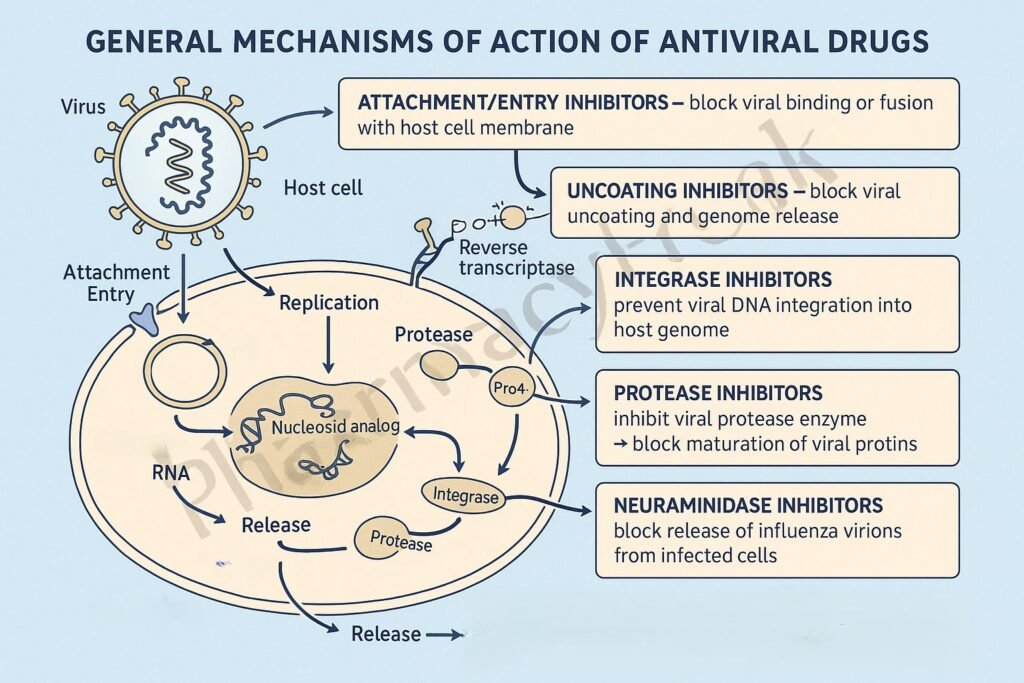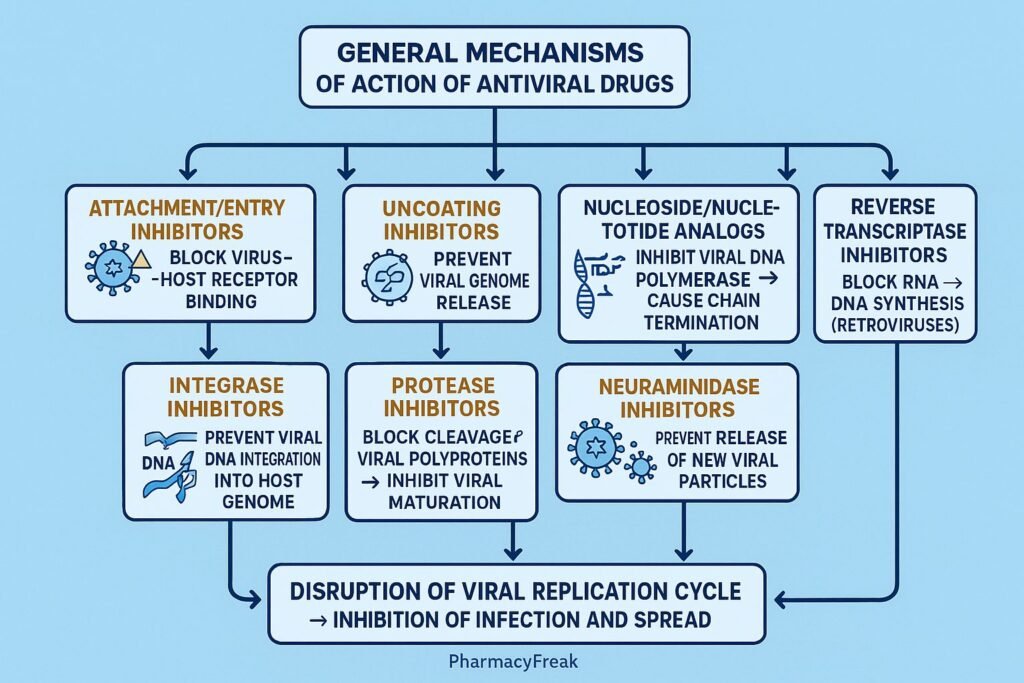Table of Contents
Introduction
Antiviral drugs are pharmacological agents that inhibit the replication of viruses within host cells. Unlike antibacterial drugs, which target cell wall or protein synthesis, antivirals act on specific stages of the viral life cycle, including attachment, entry, nucleic acid synthesis, protein processing, and viral release.
Mechanism of Action of Antiviral Drugs is based on interrupting viral replication while minimizing toxicity to host cells. Each class targets a distinct viral family — such as DNA viruses (Herpes, Hepatitis B) or RNA viruses (Influenza, HIV, Hepatitis C) — through selective inhibition of viral enzymes or structural processes.

Mechanism of Action (Step-wise)
1. Inhibition of Viral Attachment and Entry
- Mechanism:
- Block viral binding to host cell receptors or prevent fusion of viral envelope with host membrane.
- Examples:
- Enfuvirtide – binds gp41 on HIV to prevent membrane fusion.
- Maraviroc – blocks CCR5 co-receptor on host cell, inhibiting HIV entry.
- Docosanol – prevents HSV envelope fusion with host cell membrane.
- Effect: Virus unable to attach or penetrate host cell → no infection establishment.
2. Inhibition of Viral Uncoating
- Mechanism:
- Block release of viral RNA or DNA inside host cell after entry.
- Examples:
- Amantadine, Rimantadine – block M2 ion channels in influenza A virus, preventing viral uncoating.
- Effect: Viral genome remains trapped → replication cannot occur.
3. Inhibition of Viral Nucleic Acid Synthesis
- Mechanism:
- Inhibit viral DNA or RNA polymerases or act as nucleoside analogues incorporated into viral genome → chain termination.
- Examples:
- DNA viruses:
- Acyclovir, Valacyclovir – inhibit viral DNA polymerase (Herpes viruses).
- Ganciclovir – active against CMV.
- Foscarnet – non-nucleoside DNA polymerase inhibitor.
- RNA viruses:
- Remdesivir – inhibits viral RNA-dependent RNA polymerase (SARS-CoV-2).
- Ribavirin – inhibits viral RNA synthesis (Hepatitis C, RSV).
- DNA viruses:
- Effect: Prevents viral genome replication → blocks proliferation.
4. Inhibition of Reverse Transcription (HIV Therapy)
- Mechanism:
- Block conversion of viral RNA into DNA by inhibiting reverse transcriptase enzyme.
- Examples:
- Nucleoside RT inhibitors (NRTIs): Zidovudine, Lamivudine, Tenofovir.
- Non-nucleoside RT inhibitors (NNRTIs): Efavirenz, Nevirapine.
- Effect: Prevents integration of viral DNA into host genome → stops replication.
5. Inhibition of Viral Integration
- Mechanism:
- Block integrase enzyme, preventing insertion of viral DNA into the host genome (HIV).
- Examples: Raltegravir, Elvitegravir, Dolutegravir.
- Effect: Viral DNA cannot integrate → no production of viral mRNA or proteins.
6. Inhibition of Viral Protein Processing (Protease Inhibitors)
- Mechanism:
- Inhibit viral protease enzyme that cleaves polyproteins into functional viral proteins.
- Examples:
- HIV Protease Inhibitors: Ritonavir, Lopinavir, Atazanavir, Darunavir.
- Hepatitis C Protease Inhibitors: Simeprevir, Grazoprevir.
- Effect: Formation of immature, noninfectious viral particles.
7. Inhibition of Viral Assembly and Release
- Mechanism:
- Prevent budding or release of mature virions from host cells.
- Examples:
- Neuraminidase Inhibitors (Influenza): Oseltamivir, Zanamivir – prevent viral release by inhibiting neuraminidase enzyme.
- Boceprevir, Paritaprevir – inhibit HCV protease affecting assembly.
- Effect: Virus remains trapped within host cell → decreased spread.
8. Immunomodulators and Host-Targeted Agents
- Mechanism:
- Enhance host immune response or create unfavorable conditions for viral replication.
- Examples:
- Interferon-α – stimulates antiviral protein synthesis in host cells.
- Imiquimod – activates toll-like receptors (TLR7) to boost antiviral cytokine production.
- Effect: Increased antiviral state in host cells.

Comparative Summary Table
| Drug Class | Target/Mechanism | Examples | Viruses Targeted |
|---|---|---|---|
| Entry/Fusion Inhibitors | Block virus entry | Enfuvirtide, Maraviroc | HIV |
| Uncoating Inhibitors | Block M2 channel | Amantadine, Rimantadine | Influenza A |
| Nucleic Acid Inhibitors | Inhibit viral DNA/RNA polymerase | Acyclovir, Remdesivir | HSV, CMV, SARS-CoV-2 |
| Reverse Transcriptase Inhibitors | Inhibit RT enzyme | Zidovudine, Efavirenz | HIV |
| Integrase Inhibitors | Prevent integration into host DNA | Raltegravir | HIV |
| Protease Inhibitors | Prevent viral protein cleavage | Ritonavir, Simeprevir | HIV, HCV |
| Neuraminidase Inhibitors | Inhibit viral release | Oseltamivir, Zanamivir | Influenza |
| Immunomodulators | Stimulate host defense | Interferon-α, Imiquimod | HBV, HPV, HCV |
MCQs
1. Acyclovir acts by inhibiting:
a) Viral RNA polymerase
b) Viral DNA polymerase
c) Reverse transcriptase
d) Protease enzyme
Answer: b) Viral DNA polymerase
2. Oseltamivir inhibits:
a) RNA polymerase
b) Neuraminidase enzyme
c) Reverse transcriptase
d) Integrase
Answer: b) Neuraminidase enzyme
3. Zidovudine belongs to which class?
a) Protease inhibitor
b) Nucleoside reverse transcriptase inhibitor
c) Neuraminidase inhibitor
d) DNA polymerase inhibitor
Answer: b) Nucleoside reverse transcriptase inhibitor
4. Raltegravir inhibits:
a) Reverse transcriptase
b) Integrase enzyme
c) Protease enzyme
d) Neuraminidase enzyme
Answer: b) Integrase enzyme
5. Remdesivir acts by:
a) Blocking viral entry
b) Inhibiting RNA-dependent RNA polymerase
c) Inhibiting protease
d) Blocking M2 ion channel
Answer: b) Inhibiting RNA-dependent RNA polymerase
6. Which antiviral prevents viral uncoating?
a) Amantadine
b) Acyclovir
c) Zidovudine
d) Ritonavir
Answer: a) Amantadine
7. Protease inhibitors act during which viral life cycle stage?
a) Entry
b) Genome replication
c) Protein processing
d) Release
Answer: c) Protein processing
8. Interferon-α acts by:
a) Inhibiting neuraminidase
b) Stimulating host antiviral proteins
c) Blocking RNA polymerase
d) Inhibiting protease
Answer: b) Stimulating host antiviral proteins
9. Which antiviral inhibits the CCR5 co-receptor?
a) Maraviroc
b) Enfuvirtide
c) Zidovudine
d) Ritonavir
Answer: a) Maraviroc
10. The drug used for both Hepatitis B and HIV is:
a) Tenofovir
b) Acyclovir
c) Oseltamivir
d) Ganciclovir
Answer: a) Tenofovir
FAQs
Q1. How are antiviral drugs different from antibiotics?
Antivirals target virus-specific enzymes or steps in replication, while antibiotics act on bacterial structures.
Q2. Can antivirals cure viral infections?
Most suppress viral replication but do not eliminate latent viruses completely (e.g., HIV, HSV).
Q3. Why are antivirals virus-specific?
Because each virus has unique enzymes (e.g., reverse transcriptase, protease) not shared with others.
Q4. Why are antivirals less toxic than before?
Modern agents selectively target viral enzymes without affecting host cellular machinery.
Q5. Which antivirals are used for COVID-19?
Remdesivir, Molnupiravir, and Nirmatrelvir–Ritonavir (Paxlovid) inhibit SARS-CoV-2 replication.
References
- Goodman & Gilman’s The Pharmacological Basis of Therapeutics
- Katzung BG. Basic and Clinical Pharmacology
- Tripathi KD. Essentials of Medical Pharmacology
- Harrison’s Principles of Internal Medicine
Related Internal Links

I am pursuing MBA in pharmaceutical management from NIPER Hyderabad with a strong academic record and proven success in national-level pharmacy entrance exams. I secured AIR 61 in NIPER 2024 (MS/M.Pharm) and AIR 27 in NIPER MBA, along with AIR 147 in GPAT 2024 and AIR 907 in GPAT 2023. I also achieved AIR 6 in AIIMS CRE-2025 for Drug Store Keeper and was selected as a Pharmacist (AIR 61) for ESIC. Additionally, I was the Runner-Up in Round 2 of the EY Case Study Competition.
At PharmacyFreak.com, I aim to guide future pharmacists through expert content, exam strategies, and insightful resources based on real experience and academic excellence.
Mail- harsh@pharmacyfreak.com
